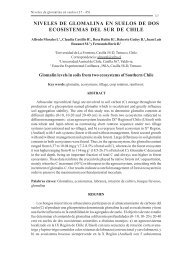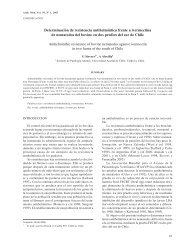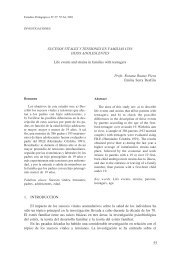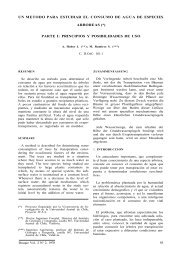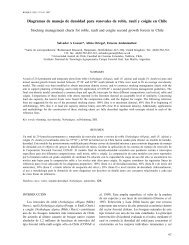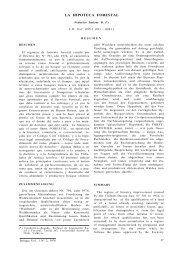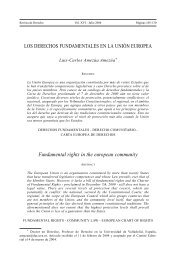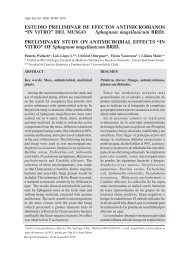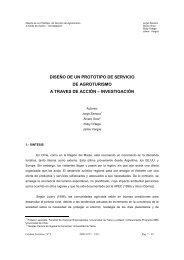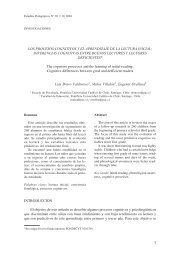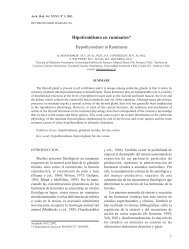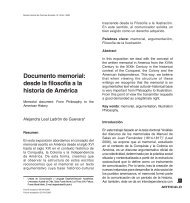Pérdida de peso seco en hojarasca de Alnus acuminata en la ...
Pérdida de peso seco en hojarasca de Alnus acuminata en la ...
Pérdida de peso seco en hojarasca de Alnus acuminata en la ...
You also want an ePaper? Increase the reach of your titles
YUMPU automatically turns print PDFs into web optimized ePapers that Google loves.
PABLO G. ACEÑOLAZA, JUAN F. GALLARDO-LANCHO<br />
<strong>de</strong> <strong>en</strong>tre el 46 y el 61 % para A. nepal<strong>en</strong>sis <strong>de</strong>spués<br />
<strong>de</strong>l primer año <strong>de</strong> <strong>de</strong>scomposición; este último<br />
valor es comparable al 55% obt<strong>en</strong>ido tras el primer<br />
año <strong>en</strong> <strong>hojarasca</strong> <strong>de</strong> A. rubra (Vogt et al.,<br />
1980) y A. crispa (Van Cleve, 1971).<br />
Consecu<strong>en</strong>tem<strong>en</strong>te, se pier<strong>de</strong> cerca <strong>de</strong>l 22% <strong>de</strong><br />
<strong>la</strong>s hojas <strong>de</strong> A. <strong>acuminata</strong> <strong>en</strong> los bosques<br />
tucumanos durante los primeros 30 días, llegando<br />
a valores <strong>de</strong> <strong>en</strong>tre el 35 y el 55% tras el primer<br />
año <strong>de</strong> <strong>de</strong>scomposición; estos valores pue<strong>de</strong>n consi<strong>de</strong>rarse<br />
algo m<strong>en</strong>ores que <strong>la</strong>s pérdidas <strong>en</strong>contradas<br />
<strong>en</strong> otras especies <strong>de</strong>l mismo género <strong>en</strong> el Hemisferio<br />
Norte.<br />
Influ<strong>en</strong>cia <strong>de</strong> <strong>la</strong> edad <strong>de</strong>l bosque. La comparación<br />
<strong>de</strong> los tratami<strong>en</strong>tos por medio <strong>de</strong> un ANOVA<br />
se expuso <strong>en</strong> el cuadro 2. Exist<strong>en</strong> difer<strong>en</strong>cias altam<strong>en</strong>te<br />
significativas (p < 0.01) <strong>en</strong>tre el bosque<br />
maduro y los otros dos estudiados, mi<strong>en</strong>tras que<br />
<strong>en</strong>tre el bosque jov<strong>en</strong> y viejo <strong>la</strong>s difer<strong>en</strong>cias sólo<br />
son <strong>de</strong> un 5%. Esto podría significar que el índice<br />
<strong>de</strong> <strong>de</strong>scomposición está regido por <strong>la</strong>s condiciones<br />
microambi<strong>en</strong>tales exist<strong>en</strong>tes <strong>en</strong> aquéllos (aunque<br />
<strong>la</strong> composición difer<strong>en</strong>te <strong>de</strong> <strong>la</strong>s hojas según <strong>la</strong> edad<br />
<strong>de</strong>l bosque podría t<strong>en</strong>er su importancia; se está<br />
procedi<strong>en</strong>do <strong>en</strong> <strong>la</strong> actualidad al análisis <strong>de</strong> <strong>la</strong>s citadas<br />
hojas, pues no se pue<strong>de</strong> rechazar a priori <strong>la</strong><br />
exist<strong>en</strong>cia <strong>de</strong> este último factor intrín<strong>seco</strong>).<br />
Edmonds (1979) y Sharma y Ambasht (1987)<br />
<strong>en</strong>contraron una mayor <strong>de</strong>scomposición al producirse<br />
el cerrami<strong>en</strong>to <strong>de</strong>l dosel arbóreo, lo que crea<br />
condiciones microambi<strong>en</strong>tales <strong>de</strong> temperatura y<br />
humedad más favorables para <strong>la</strong> <strong>de</strong>scomposición<br />
<strong>de</strong> <strong>la</strong> <strong>hojarasca</strong>; esto podría explicar <strong>la</strong>s difer<strong>en</strong>cias<br />
que se establec<strong>en</strong> <strong>en</strong>tre el bosque jov<strong>en</strong> y los<br />
dos restantes. Pue<strong>de</strong> p<strong>en</strong>sarse que <strong>en</strong> el bosque<br />
viejo <strong>la</strong> muerte <strong>de</strong> los árboles y <strong>la</strong> caída <strong>de</strong> gran<strong>de</strong>s<br />
ramas pudiera volver a abrir c<strong>la</strong>ros que expliqu<strong>en</strong><br />
<strong>la</strong> difer<strong>en</strong>cia <strong>en</strong>contrada con el bosque maduro.<br />
Por tanto, <strong>de</strong>l análisis <strong>de</strong> <strong>la</strong> dinámica <strong>de</strong> <strong>de</strong>scomposición<br />
<strong>de</strong> <strong>hojarasca</strong> <strong>de</strong> A. <strong>acuminata</strong> se pue<strong>de</strong><br />
establecer un primer período <strong>de</strong> pérdida <strong>de</strong> <strong>peso</strong><br />
re<strong>la</strong>tivam<strong>en</strong>te rápido, que se exti<strong>en</strong><strong>de</strong> durante los<br />
primeros 30 ó 40 días, y posteriorm<strong>en</strong>te un segundo,<br />
durante el cual dicha pérdida <strong>de</strong> materia es<br />
progresivam<strong>en</strong>te m<strong>en</strong>or. Las difer<strong>en</strong>cias significativas<br />
<strong>en</strong>contradas <strong>en</strong> <strong>la</strong> <strong>de</strong>scomposición <strong>de</strong> hojas<br />
proce<strong>de</strong>ntes <strong>de</strong> alisedas <strong>de</strong> difer<strong>en</strong>tes eda<strong>de</strong>s pue<strong>de</strong>n<br />
explicarse por el cerrami<strong>en</strong>to <strong>de</strong>l dosel arbóreo,<br />
aunque <strong>la</strong> posible composición distinta <strong>de</strong> <strong>la</strong>s hojas<br />
pudiera t<strong>en</strong>er también una m<strong>en</strong>or influ<strong>en</strong>cia.<br />
AGRADECIMIENTOS<br />
Al Dr. Gerardo Mor<strong>en</strong>o por su co<strong>la</strong>boración <strong>en</strong> el<br />
tratami<strong>en</strong>to <strong>de</strong> datos.<br />
BIBLIOGRAFIA<br />
ACEÑOLAZA, P. G., H.R. GRAU, M.F. ARTURI, A.D.<br />
BROWN. 1992. "Estructura y dinámica <strong>de</strong> bosques<br />
montanos <strong>de</strong>l noroeste arg<strong>en</strong>tino", Actas II Congreso Latinoamericano<br />
<strong>de</strong> Ecología. Caxambú, Brasil (<strong>en</strong> pr<strong>en</strong>sa).<br />
BOCOCK, K.L. 1964. "Changes in the amount of dry matter,<br />
N.C. and <strong>en</strong>ergy in <strong>de</strong>composition wood<strong>la</strong>nd leaf litter in<br />
re<strong>la</strong>tion to the activities of the soil fauna", J. Ecol. 52: 273-<br />
284.<br />
BOCOCK, K.L., O.J. GILBERT, C.K. CAPSTICK, DC.<br />
TURNER, J.S. WARD, M.J. WOODMAN. 1960. "Changes<br />
in leaf litter wh<strong>en</strong> p<strong>la</strong>ced on the surface of soil with<br />
contrasting humus type", J. Soil Sci. 11: 1-9.<br />
DAUBENMIRE, R., DC PRUSSO. 1963. "Studies of the<br />
<strong>de</strong>composition rates of tree litters", Ecology 44: 589-592.<br />
DYER, M.L., V. MEENTEMEYER, B. BERG. 1992.<br />
"Appar<strong>en</strong>t controls of mass loss of leaf litter on a regional<br />
scale: Litter quality vs. climate", Scand. J. For. Res. 5: 311-<br />
323.<br />
EDMONDS, R.L. 1979. "Litter <strong>de</strong>composition and nutri<strong>en</strong>t<br />
release in Doug<strong>la</strong>s-fir needle litter in re<strong>la</strong>tion to stand<br />
<strong>de</strong>velopm<strong>en</strong>t", Can. J. For. Res. 9: 132-140.<br />
EWEL, J.J. 1976. "Litter fall and leaf <strong>de</strong>composition in a tropical<br />
forest succession in Eastern Guatema<strong>la</strong>", J. Ecol. 64:<br />
293-308.<br />
GOSZ, J.R., G.E. LIKENS, F.H. BORMAN. 1973. "Nutri<strong>en</strong>t<br />
release from <strong>de</strong>composition leaf and branch litter in the<br />
Hubbard Brook forest, N.H.", Ecol. Monograph, 43: 173-<br />
191.<br />
HERNANDEZ, I.M., I. SANTA REGINA, J.F. GALLARDO.<br />
1992. Dinámica <strong>de</strong> <strong>la</strong> <strong>de</strong>scomposición <strong>de</strong> <strong>la</strong> <strong>hojarasca</strong> forestal<br />
<strong>en</strong> bosques <strong>de</strong> <strong>la</strong> Cu<strong>en</strong>ca <strong>de</strong>l Duero: Mo<strong>de</strong>lización <strong>de</strong><br />
<strong>la</strong> pérdida <strong>de</strong> <strong>peso</strong>. Arid. Soil. Res. & rehabil., 6: 339-355.<br />
JANSSON, P.E., B. BERG. 1985. "Temporal variation of<br />
<strong>de</strong>composition in re<strong>la</strong>tion to simu<strong>la</strong>ted soil climate: Longterm<br />
<strong>de</strong>composition in a Scots pine forest", Can. J. Bot. 63:<br />
1008-1016.<br />
JEWEL, W.J. 1971. "Aquatic weed <strong>de</strong>cay: dissolved oxyg<strong>en</strong><br />
utilization and N and P reg<strong>en</strong>eration", J. Water Pollution<br />
Control 43: 1457-1467.<br />
SANTA REGINA, I. 1987. Contribución al estudio <strong>de</strong> <strong>la</strong> dinámica<br />
<strong>de</strong> <strong>la</strong> materia orgánica y bioelem<strong>en</strong>tos <strong>en</strong> bosques <strong>de</strong><br />
<strong>la</strong> Sierra <strong>de</strong> Béjar. Tesis Doctoral. Universidad <strong>de</strong><br />
Sa<strong>la</strong>manca, 464 pp.<br />
SHARMA E., R.S. AMBASHT. 1987. "Litterfall, <strong>de</strong>composition<br />
and nutri<strong>en</strong>t release in an age sequ<strong>en</strong>ce of <strong>Alnus</strong><br />
nepal<strong>en</strong>sis p<strong>la</strong>ntation stands in the Eastern Hima<strong>la</strong>ya", J.<br />
Ecol. 75: 997-1010.<br />
VAN CLEVE, K. 1971. Energy and weight loss functions or<br />
<strong>de</strong>composing foliage in birch and asp<strong>en</strong> forests in Interior<br />
A<strong>la</strong>ska. 52: 720-723.<br />
VILAS BOAS, O., A.C. IMBACH, M.J. MAZZARINO, A.<br />
BONNEMANN, J. BEER. 1993. Descomposición <strong>de</strong> <strong>la</strong><br />
<strong>hojarasca</strong> <strong>en</strong> sistemas agroforestales <strong>de</strong> Cordial y Erythrina<br />
<strong>en</strong> Turrialba, Costa Rica. I. Congreso Forestal Español,<br />
Lorizán (España) 1: 343-350.<br />
VOGT, K.A., R.L. EDMONDS, G.C. ANTOS, D.G. VOGT.<br />
1980. "Re<strong>la</strong>tionship betwe<strong>en</strong> CO 2 evolution, ATP<br />
conc<strong>en</strong>tration and <strong>de</strong>composition in four ecosystems in<br />
Western Washington", Oikos, 35: 72-79.<br />
WIEDER, R.K., G.E. LANG. 1982. A critique of the analytical<br />
methods used in examining <strong>de</strong>composition data obtained<br />
from litter bags, Ecology 63: 1636-1642.<br />
WITKAMP, M. 1966. "Decomposition of leaf litter in re<strong>la</strong>tion to<br />
<strong>en</strong>vironm<strong>en</strong>t microflora respiration", Ecology 47: 194-201.<br />
Recibido: 22.12.93<br />
54



